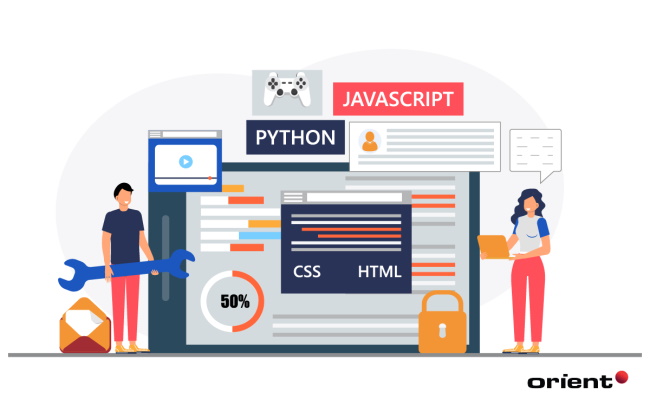The 7 Stages of the Web Application Development Process

Content Map
More chaptersIf you want to build a new website application, chances are, you will need to hire a software development team. But, with so many vendors out there, all vying for your business, choosing the right team can be tricky.
One way to make the choice easier is to become familiar with the web application development process, to know what goes on behind the scenes, including the steps involved, methods, and industry best practices. With this knowledge, you’ll have an easier time figuring out which vendor can deliver on what they promise.
What is Web App Development?
Web app development is the process of building an application program; to be specific, an application program that is stored on a server, delivered to users through an active internet connection, via a web browser. Since web apps are accessed online, users do not need to download, or store, web apps on their device - be it a desktop workstation, laptop, or mobile device - in order to run them.
Different kinds of web apps exist to serve different purposes. They can be as simple as a static, one-page online form, or they can be incredibly complex, like the full Microsoft 365 Office Suite, complete with feature-rich, cloud-based versions of familiar software, such as Microsoft Word, Excel, and Publisher.
There are many steps involved in the web application development process. And the amount of work performed at each step depends on the project scope. Your vision, budget, timeline, staffing requirements, and technological requirements will also play a factor. Generally speaking, though, a web application development process will include the following steps:
- 1. Information gathering
- 2. Planning and blueprints
- 3. Web application design
- 4. Coding and programming
- 5. Copywriting and labeling
- 6. Testing, reviewing, and launching
- 7. Post-launch maintenance and updates
Step-by-Step Breakdown of the Web Application Development Process
Information Gathering
During your first meeting with the software development team, they will take the time to learn about you, including your business and how it works. They will listen to your ideas, challenges, objectives, target audience, and what you hope to achieve with the web app. From there they will guide you through the decision-making process and narrow down the list of technology that best fits your needs.
The development team may ask you to send a breakdown of your requirements in writing. This way, they can thoroughly assess your project and technological needs and ensure a plan is in place, so that they can build a web app that is intuitive, gorgeously designed, and programmed flawlessly.
Pitfalls to Avoid
In the information gathering stage, one of the biggest mistakes is to misunderstand your target audience and what your users really want.
Ideally, every aspect of your web app, from the menu layout to the call-to-actions, should help satisfy each of your users’ demands and pain points. Therefore, make sure the development team understands your target audience and knows how to make design choices that ultimately enhance the user experience.
Questions to Ask
- “Do you have previous experience creating web apps for this type of user?”
- “What technology stack will be required to create this web app?”
- “Can you provide a fixed timeline and quote upfront?
Team Formation, Sketches, and Existing Code Review
A dedicated team manager will be assigned to your project. They will be in charge of assigning the most highly skilled and suitable team members for your project. They will also oversee every step of the project, from planning and designing to programming and post-launch support. Most importantly, they will keep you up to date with progress reports as well as document and share your feedback with the development team.
Once the team is assigned, a UI/UX designer may prepare a series of sketches. These sketches are typically wireframes; simple, stripped-backed diagrams, devoid of creative visual elements - i.e. color, graphics, custom fonts - so as to represent the web app layout in its most basic form. Sketches are designed to help you, the client, get an idea of what the final layout will look and feel like, before the design work begins.
If your organization has any existing codebases, such as pre-existing apps or websites, the development team will review these codes. Doing this will ensure the team gets off to a fresh and clean start, while removing any bugs or code inconsistencies that may impact the quality of the web app.
Pitfalls to Avoid
Client input is incredibly valuable during this stage, as your input will determine the look and feel of your web app. Therefore, it is vital that you have a clear vision. You should know what you want your web app to look like, as well as the type of user experience you hope to give your target audience.
If your input is vague or indecisive, the development team will have a harder time trying to achieve your project goals. So be as clear and specific as you can be. And if you are unsure about anything, simply ask. The team will be happy to help you make the right choices.
Questions to Ask
- “How many design sketches will you show me?”
- “Will these sketches take into account cross-device compatibility?
- “How many revisions can I request?”
- “Will these sketches leave room for increased scalability (i.e new features, new options, and new services)?”
Web Application Design
The next step is to perfect the design and interactive elements of your web app. The designer, by following the agreed sketches, will create various mockups, each with its own unique color scheme, font, graphics, buttons, transitions, and more. You will have the chance to review each submission, pick your favorite, and provide feedback - until you are satisfied with the final look and feel of the web app.
Pitfalls to Avoid
Whether you have a clear vision for a design, or you are unsure which direction to take, it’s important that you communicate with your designer. They will listen to your ideas and help you make tough creative choices.
More importantly, your designer will help you make sense of the type of web app you wish to build, the right style choices (that represent your target audience), and the technological requirements of your app. This way, you will have a clear understanding as to why your design choices will work.
Questions to Ask
- “Can you implement my existing brand or style guide into the web app?”
- “How will your choice of color take into account the user experience?
- “How will you ensure the web app is both visually appealing and well-performing?”
Coding and Programming
Once the aesthetics of the web app are established, the next step is to make it functional, which involves programming the front-end and back-end aspects of the web app.
Front-end development is the use of different web technologies, such as HTML, CSS, and JavaScript, to build the parts of the web app that the user can see and interact with. Meanwhile, back-end development means working on the server-side software, which focuses on everything the user cannot see, such as databases, back-end logic, Application Programming Interfaces (APIs), and architecture.
Search Engine Optimization (SEO) may also be conducted to help the web app achieve higher rankings on search engines like Google.
Pitfalls to Avoid
Depending on the project scope, it may be a few weeks until the coding and programming stage is done. During this stage, you should be receiving regular updates, whether it be written or verbal updates, or a combination of both.
Either way, the team should be advising you on the milestones they complete and any challenges they come across. Any issues they discover, and that require your input, should be communicated to you in a prompt, swift manner. This way you and the team can overcome any issues together.
Questions to Ask
- “What is the estimated timeline for coding and programming?”
- “Can you explain to me the different web technologies you are using and how they benefit our organization?
- “Can I request a change of scope midway through the development stage?”
Content Writing and Labeling
At this stage, you will have the layout and design set in stone, which means the team will move on to the next step: content writing and labeling.
Having clear, concise, and legible copy is a great way to enhance the user experience. With good copy, your users will be able to make sense of what your web app can do, where they can go, and the kind of outcomes they can expect when they perform certain actions.
The various types of content your web app needs will include: headings, sub-headings, descriptions, button labels, guides, and call-to-actions, to name a few. In collaboration with the artists and designers, the writer(s) will make sure the right text is in the right place.
Pitfalls to Avoid
Like previous steps, make sure the focus is on the target audience. Your written content should address your user’s primary needs, concerns, and pain points. It should explain to them, clearly and succinctly, what your app can do and how they can use the various features to achieve their goals. Furthermore, the content should be written in a way that it does not assume the user knows more than they actually do.
Questions to Ask
- “Do you have a dedicated writer or team of writers?”
- “What are their relevant skills and experience in web app and UI content writing?”
- “How will you translate the web app’s features into user-oriented benefits?”
Testing, Reviewing, and Launching
Testing is one of the most important steps in the web application development process. It confirms that the web app works as intended and meets all relevant organization, industry, and global standards.
Testing is usually carried out by a dedicated Quality Assurance (QA) team. They will perform a combination of manual and automated testing to detect bugs, errors, crashes, and other issues. They will test virtually every aspect of the software, including the quality of the user experience, level of security, performance, functionality, and responsiveness. The QA team will notify the development team of any issues or areas of non-compliance, for which they will be responsible for fixing. Once the web app meets all quality standards, it can be launched on common browsers.
Pitfalls to Avoid
While we have mentioned testing near the end of the development cycle, the reality is, testing should be carried out at almost every step of the process. This ensures that bugs, errors, and UI issues are caught and resolved early - before the project gets too far in the development cycle, making them easier to fix.
In addition to this, web application testing should take into account not just the user experience, but also safety and security. Any gaps in the web app’s security could leave it vulnerable to cyber security attacks and unauthorized breaches.
Questions to Ask
- “How often do you perform web application testing throughout the development cycle?”
- “What kind of web application testing tools do you use?”
- “Will you test every aspect of the software i.e. performance, usability, security?”
Post-Launch Maintenance and Updates
No matter how big or small, every web app needs regular maintenance. These can be in the form of small patches that bring usability improvements, to more significant updates that introduce new features and capabilities. Regular maintenance can also help uncover previously undiscovered bugs and errors.
The software development team should have a priority system in place, so that the most urgent and serious bugs are resolved first. This will give users the confidence that their voice is being heard, and that the organization behind the web app is committed to providing the best possible user experience.
In the unlikely event of a major security breach, the development team should be ready to communicate the issue to the wider community, so that the users can take the necessary steps to protect their accounts and data (i.e. change passwords, enable multi-factor authentication). Of course, with regular maintenance, it is possible to find and resolve a security vulnerability before a major security breach takes place.
Pitfalls to Avoid
Plans for continuous delivery and improvement should be established early on in the project lifecycle. This plan needs to take into account smaller, minor patches and usability improvements, as well as the potential for more significant updates such as the implementation of new features.
Keep in mind that the feedback from your users must be taken into consideration as well. If they report an unexpected bug or error, one that seriously impacts the user experience, these kinds of issues should be resolved promptly. Even a small complaint about the user interface should not be ignored. Such feedback could reveal insight into the web app that was previously not considered, thus allowing room for improvement.
Questions to Ask
- “What kind of post-launch support and maintenance do you offer?”
- “How frequently should my web app, of this size and scope, be updated?”
- “How quickly does your team respond to user complaints and bug reports?”
Choosing the Right Software Development Team

Ultimately, whether you are building a basic static web app or a dynamic multi-page app, choosing the right team is essential to a successful outcome. The right software development team will listen to your ideas, translate them into a viable plan, and follow through on that plan until you are satisfied with the end result. Most important of all, you will know just what to expect each step of the way, including the estimated time of delivery and budget.
With all of this information on your side, you will be able to choose a software development team who has your best interests at heart, and who can deliver on what they promise. Therefore, you are more likely to receive a high-quality web application, one that will help you achieve your short and long-term business goals.







